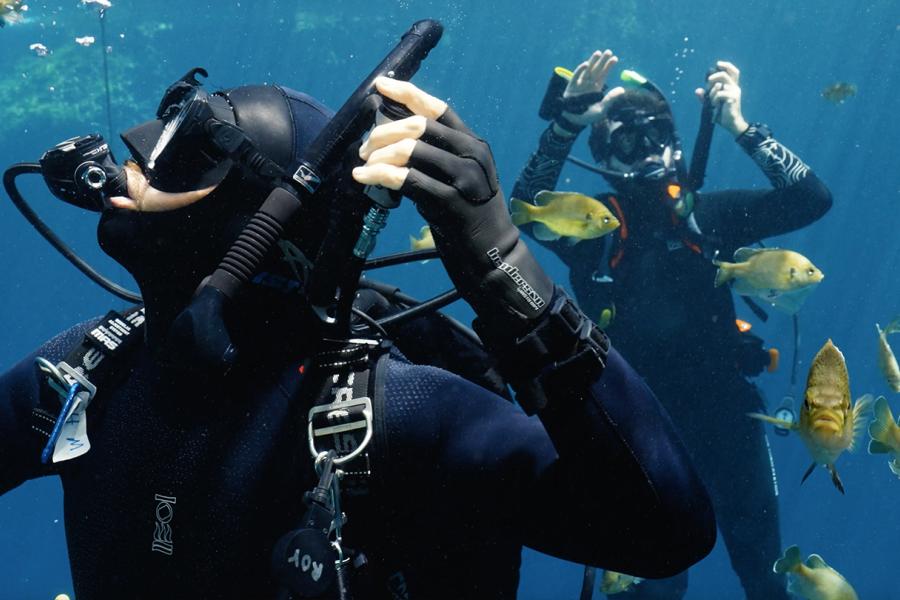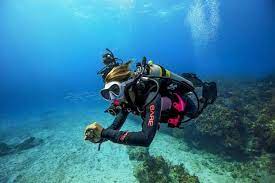To ensure your mini scuba tank regulator setup works smoothly, perform these 5 checks: 1) Verify thread compatibility (most mini tanks use CGA-347 or DIN); 2) Confirm working pressure range (200-300 PSI for mini tanks); 3) Check O-ring integrity (replace if cracked); 4) Test airflow rate (0.5-1.5 CFM for recreational use); 5) Inspect hose connections for leaks (submerge in water to detect bubbles). Always match regulator specs to your tank’s valve type and pressure rating.
Check the Thread Type
Most mini scuba tanks use one of two common thread standards: CGA-347 (common in North America) or DIN (popular in Europe and technical diving).
The CGA-347 is a yoke-style connection with a standard 0.825-14 NGO thread, typically found on aluminum tanks under 2000 PSI. The DIN system, on the other hand, uses a threaded insert with either G5/8" (common for 200-300 bar setups) or M26x2 (for specialized European valves). If you’re using a DIN regulator on a CGA tank (or vice versa), you’ll need an adapter, which costs between 50 depending on material and brand.
CGA-347 has a wider, coarser thread, while DIN threads are finer and deeper. If you’re unsure, measure the outer diameter (OD)—CGA-347 is roughly 0.825 inches (21mm), while DIN threads vary between 18mm (G5/8") and 26mm (M26x2).
For example, Paintball tanks (like those from Empire or Tippmann) often use a different standard (1/8" NPT or 3000 PSI CGA-320), which won’t fit standard scuba regulators without an adapter. Similarly, some European mini tanks use M18x1.5 threads, requiring a specific DIN variant.
A mismatched thread can cause slow leaks (1-3 PSI per minute), reducing dive time. For example, a 13 cu ft tank (2000 PSI) losing 2 PSI per minute would lose 120 PSI in an hour, cutting your dive short.
If you’re buying a new regulator, cross-check the thread type with your tank’s valve. Brands like Scubapro, Apeks, and Aqua Lung clearly label thread compatibility. If you’re using a used or modified tank, inspect the valve for wear—corroded or cross-threaded connections can fail at depth.
Quick Reference: Common Mini Scuba Tank Thread Types
|
Thread Type |
Common Use |
Outer Diameter |
Pressure Range |
Adapter Needed? |
|---|---|---|---|---|
|
CGA-347 |
North American mini tanks |
0.825" (21mm) |
Up to 2000 PSI |
Only for DIN regulators |
|
DIN G5/8" |
European/tech diving |
18mm |
200-300 bar |
Only for CGA tanks |
|
M26x2 |
Specialized EU valves |
26mm |
200-300 bar |
Rare, needs specific regulator |
|
1/8" NPT |
Paintball tanks |
~0.4" (10mm) |
3000 PSI |
Requires CGA adapter |
Finally, Dry threads can seize after 5-10 uses, making disassembly difficult. A small tube of Tribolube or O2-compatible grease costs 15 and lasts for 50+ dives.

Test Pressure Range
Most mini tanks operate between 2000-3000 PSI (138-207 bar), but specialty units can hit 4500 PSI (310 bar). Your regulator must handle both the tank’s maximum fill pressure and the working pressure during the dive, or you’ll risk freeze-ups, erratic breathing resistance, or burst discs blowing prematurely.
Standard recreational regulators are typically rated for 3000-3500 PSI input, which covers most aluminum mini tanks. But if you’re using a carbon fiber or steel tank, you might be dealing with 3442 PSI (237 bar) or higher—exceeding your regulator’s limit by 10-15%. That’s not just dangerous; it voids warranties and can crack the first-stage housing. High-pressure (HP) regulators, like those from Scubapro or Apeks, are built for 4000+ PSI systems and cost 150 more than standard models.
For example, a 3000 PSI regulator on a 4500 PSI tank might work initially, but as the tank empties, pressure drops can cause intermittent free-flow—wasting 20-30% of your air in the first 10 minutes. Conversely, using an HP regulator on a low-pressure tank (like a standard 2000 PSI aluminum cylinder) can lead to weak airflow because the spring tension isn’t optimized for lower pressures.
Testing is simple: If it’s 3000 PSI or less, don’t pair it with a tank that exceeds that. For existing setups, monitor performance during the first 5 minutes of a dive. If breathing feels stiff at the start but eases later, your regulator isn’t balanced for the tank’s pressure curve.
Field test tip: If you’re unsure about compatibility, do a shallow (10-15 ft) test dive with a half-full tank. Watch for sudden airflow changes—a sign your regulator can’t handle the pressure swing.
Inspect O-Rings
This little guy handles 3000+ PSI and fails most often—a single grain of sand can carve a leak path losing 2 cubic feet per minute at depth. Saltwater divers see these fail 40% faster than freshwater users due to corrosion. The second-stage mouthpiece O-ring (usually 1.5mm) fails more subtly, causing that annoying free-flow that wastes 30% of your air before you notice.
Here's how to inspect them properly: Shine a flashlight at a 45-degree angle across the O-ring surface—micro-cracks will cast visible shadows. Roll the seal between your fingers—it should feel smooth with zero grit. Stretch it gently to 150% of its size; if it doesn't snap back completely within 3 seconds, it's done. Check for oval deformation—any O-ring that's lost its perfect circular shape by more than 5% needs replacement immediately.
Material choices matter more than most divers realize: Standard nitrile works for warm water but becomes brittle below 10°C (50°F). Viton costs three times as much but lasts five times longer in cold conditions. For oxygen-enriched systems (like technical diving), only use green-coded MIL-SPEC O-rings—the $3 price difference prevents combustion risks.
The lifespan math doesn't lie: A recreational diver doing 50 dives annually should replace all critical O-rings every 18 months regardless of visible wear. Tech divers pushing 100+ dives yearly need biannual replacements. Store spares in a lightproof container—UV exposure degrades the material 60% faster.
Installation errors cause most early failures:Seat the O-ring with a twisting motion to prevent pinching—this simple technique reduces installation damage by 75%. Never reuse an O-ring that's been compressed for more than 48 hours—the memory loss creates micro-leaks.
Field testing is non-negotiable:Submerge connections in shallow water for 30 seconds—any bubble stream thicker than 1mm diameter indicates a failing seal. Keep an O-ring pick tool in your save-a-dive kit—the $8 investment lets you replace seals without damaging grooves.
Pro tip for traveling divers: The 20-gram kit weighs less than your car keys but contains everything needed to rebuild a regulator on location.
Verify Airflow Rate
Most recreational regulators deliver between 25-35 liters per minute (LPM) at depth, but variances as small as 5 LPM can mean the difference between effortless breathing and feeling like you're sucking through a straw. When airflow drops below 20 LPM, CO₂ buildup becomes a real risk—especially below 30 meters (100 feet) where gas density increases breathing resistance by 40%.
With the regulator connected to a tank at 2000-3000 PSI, take five rapid breaths while watching the pressure gauge. A properly tuned regulator should maintain steady pressure with no more than 50 PSI drop per breath. If the needle swings wildly or the tank empties faster than expected, you've likely got an airflow restriction. Common culprits include clogged filters (reducing flow by up to 15%), misadjusted intermediate pressure (causing 10-20 LPM variance), or worn second-stage valves that can't keep up with demand.
At just 10 meters (33 feet), water pressure doubles the effort needed to draw air. A regulator that flows 30 LPM at the surface might only deliver 22 LPM at depth. Tech divers often upgrade to balanced regulators that maintain flow within 5% variance from 0-40 meters—these cost 300 more but prevent the "breathing through a pillow" sensation at depth.
Here's how to field-test airflow: During your safety stop at 5 meters (15 feet), take three consecutive deep breaths while monitoring your SPG. Each breath should consume 1-1.5 cubic feet of air—if it's using 2+ cubic feet per breath, your regulator isn't delivering efficiently. Another red flag: if your dive computer shows a sudden increase in breathing rate at constant depth, your gear might be working against you.
A regulator serviced within the last 12 months typically flows 8-10% better than one overdue for maintenance. Saltwater divers need particular attention to corrosion in the exhaust valve—just 0.5mm of mineral buildup can reduce airflow by 12%.
Upgrade considerations: If you're consistently burning through air 20% faster than your buddies at similar depths, consider a high-performance second stage like the Scubapro G260. These use larger valves to maintain 40+ LPM flow even at depth, though they add 200g of weight to your setup.
Pro tip for cold water: Below 10°C (50°F), regulator freeze can restrict airflow suddenly. Before polar dives, test breathing resistance in 5°C (41°F) water for at least 10 minutes—if flow drops more than 15%, you need an environmentally sealed model.
Look for Leaks
Even a small 1 PSI per minute leak can drain a 13 cu ft tank 30% faster, turning a planned 45-minute dive into a rushed 30-minute scramble. Worse, leaks often worsen with depth—what’s a barely noticeable hiss at the surface can become a violent stream of bubbles at 20 meters (66 feet), spooking marine life and burning through your air supply.
Most leaks occur at predictable spots: The tank valve O-ring (responsible for 40% of leaks), the hose connections (25% of leaks), and the second-stage exhaust valve (20% of leaks). The remaining 15% come from less obvious places like cracked first-stage bodies or worn adjustment knobs. Saltwater accelerates corrosion in these areas, making ocean divers three times more likely to develop leaks than freshwater divers.
Here’s how to test for leaks systematically:
-
Dry Land Check – A faint hissing sound indicates a bad seal. Run your fingers along hoses—you’ll often feel air before you hear it.
-
Pressure Test – Open the tank valve fully and watch your SPG for 5 minutes. If the needle drops more than 50 PSI without you breathing, you’ve got a leak. Mark the spot with soapy water—bubbles will pinpoint the exact location.
-
Underwater Verification – Submerge the regulator in 1 meter (3 feet) of water and watch for bubble streams. Tiny, sporadic bubbles might just be trapped air, but consistent streams thicker than 2mm mean trouble.
Leak Severity Guide:
-
Minor (0.5-1 PSI/min) – Often caused by dust in O-ring grooves or slightly loose hose fittings. Fix with cleaning and re-tightening.
-
Moderate (1-3 PSI/min) – Usually from damaged O-rings or cracked hose ends. Needs parts replacement.
-
Severe (5+ PSI/min) – Likely a failed high-pressure seat or burst diaphragm. Abort the dive immediately.
Prevention beats repair: Rinse with fresh water within 2 hours of saltwater use to prevent corrosion. Replace O-rings every 100 dives and hoses every 3 years, even if they look fine.
Pro tip for traveling divers: Pack a small ultrasonic leak detector (about $80). This handheld device can find micro-leaks as small as 0.1 PSI/min that would otherwise go unnoticed until they become major problems.
When to walk away: If you find a leak in the first-stage body or HP port threads, don’t attempt a field repair.
Remember: A leak-free regulator is a stress-free dive. Test thoroughly, maintain proactively, and never ignore even the smallest air loss—your bottom time depends on it.




Laisser un commentaire
Tous les commentaires sont modérés avant d'être publiés.
Ce site est protégé par hCaptcha, et la Politique de confidentialité et les Conditions de service de hCaptcha s’appliquent.